Optimal Handling of End-of-life Electronics Means Recycling
By Brian Brundage | April 3, 2013
Category: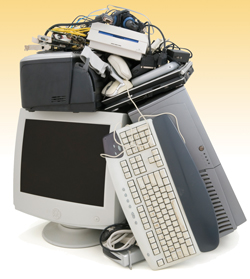
Newer. Shinier. Faster. It’s no secret that consumers seem to have an endless hunger for new electronic products. But while innovation may satisfy consumers’ wants for a better product, it creates a new problem. What to do with the nearly 50 million tons of electronic waste created each year?
The term electronic waste refers not only to a defunct smart phone or laptop computer; coffeepots, toasters, microwaves, televisions, and so forth, also are e-waste, because they all contain lead -printed circuit boards. The need to recycle these items, as well as bulbs and ballasts from warehouse operations, is growing just as the amount of e-waste society trashes grows each year.
Government has stepped in. On the local and state levels in some regions, many agencies are legislating the end-of-life handling of e-waste by banning the disposal of items such as televisions, monitors, computer components, and other household electronics
Each computer or television display contains an average of 4 to 8 pounds of lead, and monitor glass alone contains about 20 percent lead by weight, according to the Silicon Valley Toxics Coalition. In a report called “Poison PCs and Toxic TVs: California’s Biggest Environmental Crisis That You’ve Never Heard Of,” the group wrote “When these components are illegally disposed and crushed in landfills, the lead is released into the environment, posing a hazardous legacy for current and future generations.
“Consumer electronics already constitute 40 percent of lead found in landfills. About 70 percent of the heavy metals, including mercury and other hazardous substances found in electronics, can contaminate groundwater and pose other environmental and public health risks.”
Consumers may not think twice about trashing household appliances, but many of the same hazardous materials are found in these items. And when an item as seemingly innocuous as a toaster, coffeemaker, or blender ends up in a landfill, the long-term results on the environment can be devastating.
According to the United Nations Environment Program, the U.S. is the world leader in producing electronic waste.
Follow the Electronics
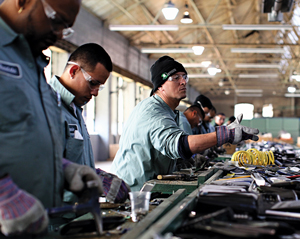
Figure 1
The most secure method of handling electronics is to have them completely demanufactured and processed for raw material value.
The first step in protecting the environment is keeping recyclable commodities out of landfills and incinerators. If it can be recycled, it must be.
Landfills are a perfect example of a good concept gone astray. Landfills originally were designed to be giant composters of sorts, where decaying, biodegradable products would leach into soil, thereby enriching it. Instead, landfills have turned into a convenient dumping ground for a variety of toxic materials and recyclable commodities.
In fact, landfill mining and reclamation (LFMR), which aims to recover valuable recyclable materials from landfills, currently is under way in several places. Solid wastes that had been land-filled now are excavated and processed.
Everything from glass, leaded glass, plastic foam, light-gauge plastic, bulbs, ballast,s and electronic waste can and should be recycled. The recycling industry is growing in leaps and bounds, with innovative companies across the globe discovering new ways to keep harmful items out of landfills.
What is needed is a commitment by manufacturers to outsource the byproducts of their operations for proper recycling. Many manufacturers do just that. However, government has stepped in to make sure that all hazardous materials are handled and recycled properly.
The U.S. Environmental Protection Agency’s (EPA) Web site, www.epa.gov, posts the regulations for disposal of cathode ray tubes (CRTs) and other hazardous electronics. Facilities that generate more than 220 lbs. (100 kilograms) of hazardous waste per month are regulated under federal law.
Regulations vary from state to state and municipality to municipality, but they often are even more stringent regarding electronic waste. For example, in California, CRTs are considered to be spent materials and are banned from landfills.
Electronics are not “trash,” because they can be demanufactured for raw metal and material value. Many electronics contain precious metals, glass, and plastics that can be used to manufacture new products. Recycling these items properly reduces the need to mine for raw materials, an expensive process with environmental ramifications. These materials are already available for reuse if they are recovered properly during the recycling process.
Electronics Security Breach
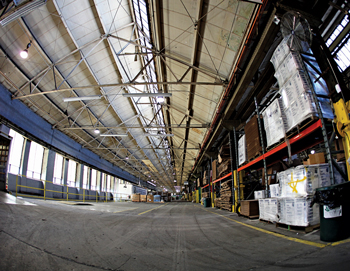
Figure 2
It is critical that incoming electronics equipment be immediately labeled, weighed, verified, and sorted upon being unloaded.
What happens to the data on electronic materials sent to landfills? Every hard drive contains potentially sensitive information such as financial data, client lists, trade secrets, valuable operational guidelines, and the like (see Figure 1). What would it mean to your business if this information ended up in the hands of a competitor? What would it mean to your customers if
their private data was made available because of inadequate handling of electronic waste?
The most secure method of handling electronics to is to have the material completely demanufactured and processed for raw material value—not redeployed. The basic flaw in the reuse approach to electronics recycling is that when the product is reused, the data is also accessible. The Department of Defense dictates that the only way information cannot be captured from hard drives is for these devices to be torn apart and recycled for raw metal components. The top priority is protecting data security, and making sure that e-waste is recycled for raw metal material value.
The best way to minimize environmental liabilities is simply not to put any electronic material that can be recycled into a landfill. Companies with the biggest pockets have the biggest liability risk.
Based on the growing statutes and regulations, more companies must address their environmental liabilities and come up with a solid plan to recycle e-waste properly.
Demanufacturing Works
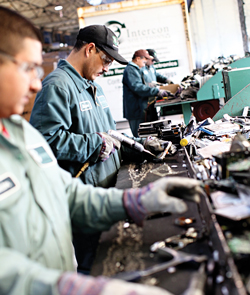
Figure 3
Glass, iron, lead, copper, aluminum, and plastics are retrieved during the demanufacturing process.
A certified, bona fide electronics recycling process is founded on implementing a demanufacturing program. This process, with established steps and procedures for the proper handling of electronics, protects companies and the environment.
1. Tracking. First, a shipment of equipment should be labeled immediately upon being unloaded (see Figure 2). Then it should be weighed, verified, and sorted based on originator and equipment type. State-of-the-art bar-coding processes that track electronics items from receipt through sorting to demanufacturing are optimal.
2. Dissasembly. Personnel performing this task should be well-trained to disassemble each item into its recyclable components and materials, such as plastics and metals, to prepare them for raw material extraction. Glass, iron, lead, copper, aluminum and plastics are retrieved during the demanufacturing process (see Figure 3).
3. Storage. The now raw materials garnered from the demanufacturing process are stored in an organized warehouse area just as though they are virgin raw materials so they can be easily retrieval. Baling and consolidating materials in lots according to the specifications lowers the overall cost of doing business and ensures that raw materials can re-enter the manufacturing process.
4. Delivery. The raw materials are delivered to smelters and refiners and then reused. For example, iron, which accounts for about 60 percent of the metal recovered from electronics, can be made into rebar for building projects. Aluminum recovered can be used to make the aluminum lawn chairs found at many a backyard barbecue. Recovered plastics might be used in parking bumpers and plastic building materials. Lead is used in the manufacture of new printed circuit boards.
How to Choose a Recycler
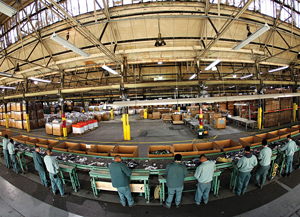
Figure 4
The most affordable and ecoconscious resolution is one that caters to your business model and avoids double handling. The demanufacturing operation shown begins with a whole product that has not required preliminary dismantling.
Manufacturers that want to be greener and to discard their electronics properly should contact a legitimate recycler that can provide consultation.
The first step in choosing a recycler is to find one with processes and purposes that are in sync with your business’s goals. The most affordable and ecoconscious resolution is one that caters to your business model and avoids double handling (see Figure 4). This is imperative because, at its core, recycling is about preservation of all resources. Easier processes for your
company mean more recycling is actually done.
You should also make sure that the recycler you choose employs approved smelters and refiners.
Certifications to look for in a recycler include R2/RIOS™, as recommended by the EPA, and National Association for Information Destuction AAA for data security. It is also recommended that you choose a recycler that operates on a management system that complements your own, such as ISO 9001, ISO 14001, and OHSAS 18001. You might even want to check out the recycler’s Better Business Bureau listing/ranking.
You may benefit from working with a recycler that provides a turnkey recycling system for material collection. Find a recycler that consolidates equipment on its end rather than on yours. This makes recycling feasible for your warehouse operations.
What does it cost to recycle electronic waste properly? In many cases, the cost is comparable to dumping it in a landfill. However, the value of data security, control of environmental liabilities, and preservation of the environment is priceless.

Side by side, we move metal fabrication forward.
FMA unites thousands of metal fabrication and manufacturing professionals around a common purpose: to shape the future of our industry, and in turn shape the world.
Learn More About FMA


